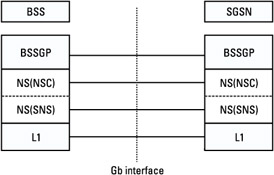Chapter 6: Gb Interface
Chapter 6: Gb Interface
This chapter covers signaling and data transfer over the Gb interface. This interface is essential, as it is the link between the GPRS core network and the BSS. It is used for the transport of GMM, packet flow management (PFM), and NM signaling.
Section 6.1 provides an overview of the Gb interface with its associated protocol stack and the services provided by the different layers. Section 6.2 covers the frame relay protocol, used as a transport network over the Gb interface. Section 6.3 explains the different levels of addressing between the SGSN and the BSS. Section 6.4 details the NS layer, and Section 6.5 deals with the BSSGP layer. Section 6.6 offers case studies showing how the different procedures interact in some typical situations, such as cell reselection.
6.1 General Overview
Figure 6.1 shows the position of the Gb interface within the GPRS network. The Gb interface is located between the BSS and the SGSN (between the gray boxes in Figure 6.1). It allows for the exchange of signaling information and user data, and the multiplexing of many users on the same physical resource. This interface is completely standardized, allowing interworking between the BSSs and SGSNs provided by different manufacturers.
 Figure 6.1: Position of the Gb interface.
Figure 6.1: Position of the Gb interface.
Figure 6.2 shows the protocol stack between the SGSN and the BSS. The NS layer has been split into two sublayers in order to have the NSC sublayer independent of the intermediate transmission network, which is based at the moment on the frame relay protocol.

Figure 6.2: Protocol stack on the Gb interface.
The peer-to-peer communication across the Gb interface between the two remote NS entities in the BSS and the SGSN is performed over virtual connections. The NS layer is responsible for the management of the virtual connections between the BSS and the SGSN (verification of the availability of the virtual connections, initialization, and restoring of a virtual connection). It ensures the distribution of upper-layer PDUs between the different possible virtual connections (load-sharing function).
The BSSGP layer ensures the transmission of upper-layer data (LLC PDUs) from the BSS to the SGSN or from the SGSN to the BSS. It ensures the transmission of GMM, PFM, and NM signaling. The peer-to-peer communication across the Gb interface between the two remote BSSGP entities is performed over virtual connections. There is one virtual connection per cell.






